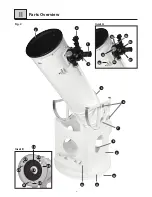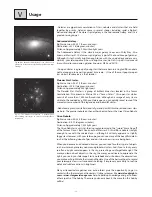
- 13 -
• Galaxies are gigantic accumulations of stars, nebulae and clusters that are held
together by gravity. Galaxies come in several shapes including spiral, elliptical,
barred and irregular. The closest spiral galaxy is the Andromeda Galaxy, and it is a
great observing target.
Andromeda Galaxy:
Right ascension: 00: 42.7 (hours: minutes)
Declination: +41: 16 (degrees: minutes)
Distance: Approximately 2.54 million light years
The Andromeda Galaxy is the closest major galaxy to our own Milky Way. Also
known as Messier 31, this famous spiral galaxy is part of the Local Group of galaxies.
Although it is technically bright enough to see with the unaided eye under a very
dark sky, your telescope may show its bright center, hints of its spiral structure and
its much smaller companion galaxies known as M32 and M110.
• An open cluster is a group of young stars that were born in a single diffuse nebula
not too long ago (on an astronomical time scale…). One of the most popular open
star clusters for observers is the Pleiades:
Pleiades Star Cluster:
Right ascension: 03: 47.0 (hours: minutes)
Declination: +24: 07 (degrees: minutes)
Distance: Approximately 444 light years
The Pleiades Star Cluster is a group of brilliant blue stars located in the Taurus
Constellation. Also known as Messier 45 or “Seven Sisters”, this open star cluster
consists of more than 1,000 confirmed stars, although an average of only six are
visible to the unaided eye. With your telescope, you can quickly reveal some of the
more elusive members of this legendary and beautiful cluster.
• Nebulae are giant interstellar clouds of gas and dust. Within those clouds new stars
are born. The premier nebula on the northern hemisphere is the Great Orion Nebula:
Orion Nebula:
Right ascension: 05: 35.4 (hours: minutes)
Declination: -05: 27 (degrees: minutes)
Distance: Approximately 1,344 light years
The Orion Nebula is a vast star-forming region located in the “sword” branching off
of the famous Orion’s Belt. Also known as Messier 42, this diffuse nebula is bright
enough to see with the unaided eye — although it will only appear as a slightly
foggy star. However, with your telescope, you can see many of the beautiful details,
such as the billowing clouds of gas and dust where new stars are being born.
When you become an advanced observer you can look for other types of objects
such as asteroids, planetary nebula and globular clusters. And if you’re lucky, every
so often a bright comet appears in the sky, presenting an unforgettable sight. The
more you learn about objects in the sky, the more you will learn to appreciate the
sights you see in your telescope. Start a notebook and write down the observations
you make each night. Note the time and the date. One of the best methods to record
your telescopic views is astronomical sketching. It improves your ability to see fine
detail and subtle variations in brightness.
Many astronomical magazines and online forms give the opportunity to get in
contact with other amateur astronomers. Online resources like www.cloudynights.
com or www.stargazerslounge.com help to build up knowledge and get to know
other aspects of the hobby. The more you know about it, the more fun this hobby
will be!
V
Fig. 20: M31, the Andromeda Galaxy, is one of the easiest
galaxies to locate and observe during the fall and winter
evenings.
Fig. 21: The Pleiades Star Cluster is probably the
most striking star cluster to observe in the Northern
Hemisphere.
Usage




















